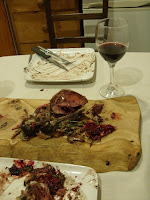Great Game (and an Edwardian revival)
 |
| Roast partridge with pickled blackberries and parsnip chips |
One of the great advantages of living in a town such as Harrogate is having ready access to amazing produce. For a small town, it still boasts plenty specialist grocers and delis, independent fishmongers, butchers and greengrocers. One thing I rarely buy, though, is game birds. The thing is, when you live in a rural area, it doesn't take long to make friends who shoot. I've lost track of the times I've arrived home from work to find something dead hanging off the back door, and I've had to teach myself to pluck, gut and clean various birds and small mammals. Mercifully, I'm not squeamish! If I know someone's going out, I might put a request in, but you never know what's coming back. Pheasants are common, but I've also had mallard, teal, pochard, partridge, rabbit and hare.
In the UK, at least, game cookery has become associated with the upper classes and country houses, and I do think it has suffered from a degree of inverse-snobbery about that. The reality is that many game birds can be bought at a reasonable price from independent butchers, good markets and a number of online specialists. If you buy from a retailer, you won't have to do the messy stuff yourself.
Where you won't find much game meat is in a supermarket. The supermarket business model doesn't welcome the variable supplies that result from nature's attempts to escape man's gun. Nor is it set up for processing small bodies that still contain the lead shot that saw them off. I suspect, too, that supermarkets thrive by distancing the consumer from the animal their food once was. Game birds, even in their oven-ready state, are just too obviously dead animals for them.
 |
| I learnt a lot from this gentleman! |
Although, we often associate game cookery with an older style of cookery, that's only because our imagination has become limited. Pheasant doesn't need bread sauce. It's delicious cooked à la normande, with cider and apples and it makes a truly amazing curry. Cook rabbit with black olives and tomatoes, as they would in Malta. Try searing pigeon breasts in butter, then flame them in herby Green Chartreuse liqueur and finish with a splash of cream.
 |
| The remains of two woodcock |
All of which brings me back to the town I've made my home. A few years ago, some internet search for something else led me to an out-of-date site that referenced a "Harrogate Sauce" for game birds. I had to find out more. It turns out that this was a popular sauce in Harrogate's Edwardian heyday, made from wine, spices and the roasting juices from the bird. Central to its wonderful, savoury flavour is mushroom ketchup, an older condiment you can get in specialist grocers or the better supermarkets. Within the UK, you can get a list of stockists on the manufacturer's website: http://www.geowatkins.com/stockists . Outside the UK, you can buy it from https://www.britishcornershop.co.uk/
Harrogate Sauce
Finely grated zest and juice of half a lemon
1/4tsp or more of ground mace
a pinch of cayenne
a good tablespoon of mushroom ketchup
Place all the above in a bowl and leave to steep while you prepare the birds.
Prepare your game birds for the oven as usual, and add 2 finely chopped shallots to the roasting tin. Roast as per your recipe, then remove the birds and let them rest in a warm place.
Add a good splash (about 30ml, perhaps) of hot water to the roasting tin and place on the hob to deglaze the tin. Scrape any sticky bits from the bottom of the tin into the water, then pour all the juices, shallots and sticky bits into a saucepan. Add the mushroom ketchup mix and place on a medium heat. Simmer for 15 minutes to reduce the sauce a little and intensify the flavour. Add a small glass of claret just before you plate up your birds. Strain the sauce into a suitably classy sauce boat and serve.
Next time: new wines from Yorkshire!




Comments
Post a Comment